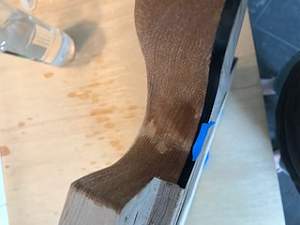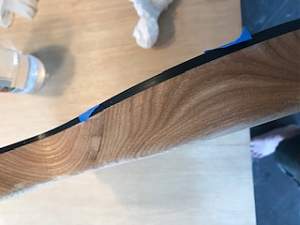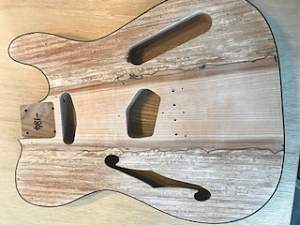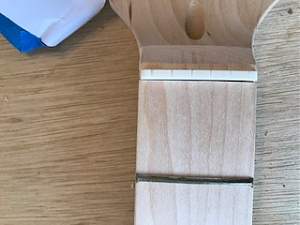Thanks Trevor and Simon
Just one final question - on the maple fretboard:
- how fine should I sand before applying TO?
- Should I sand between coats?
- should I finish with a 50/50 diluted TO coat?
Thanks
Thanks Trevor and Simon
Just one final question - on the maple fretboard:
- how fine should I sand before applying TO?
- Should I sand between coats?
- should I finish with a 50/50 diluted TO coat?
Thanks
Iíd probably sand up to p400 and then see how smooth it feels to you. The neck will be a lot smoother than the body was to start with, so donít start with anything too coarse, especially on the fretboard. Concentrate on getting the marker dot areas smooth, sometimes they can stand a bit proud.
The fine sanding will really be on the finish. Youíll mark the frets and get finish on them, so after finally sanding the board surface finish down, youíll want to tape it off and then fine sand and polish the frets. If you want a glossy board, then you can do the final board and fret polishing together if you want.
Donít sand between coats unless youíve got a lot of dust or dirt sticking to a coat. The coats are thin, and itís easy to sand off two or more layer thicknesses in one go. Any particle removal sanding needs to be as light as possible and with a fine grit, the finest that will do the job. Start really fine and move to the next grit down until you get a result.
You donít need to finish with diluted coats, but they may help to get a glossier look to the finish before you start sanding. They certainly wonít do any harm.
I thought I posted this last night, but apparently forgot to hit the "post" button. Maybe too late but I'll post anyway...
I don't want to add to your confusion, but I will make a couple of points re: your neck finishing steps.
First, re: thinning Tru Oil - Mineral Turpentine aka: Mineral Turps. (I see your in Sydney, but maybe from somewhere else?) I just don't see White Spirit used in AUS - but it is the same as Mineral Turpentine). FWIW I have not felt the need to thin Tru Oil at any point through the process and have achieved excellent results on both body and necks.
IME/O, the fretboard generally does not require sanding unless there are fret marker dots not sitting flush to the fb. In which case I prefer scraping to sanding (happy to provide more on that if you want later).3. Sand fretboard, headstock and neck 320g
Sanding between the frets can be problematic because it's difficult to sand evenly right up the metal fret, and the narrower the fret spacing the harder it gets. As a result, people sometimes sand across the fb which is also across the grain and all you're left with is scratches. And most of the time these scratches will be visible through the clear coat.
There is nothing wrong with applying finish to the entire heel of the neck. In fact it is industry standard. Pull a neck off a production-line Fender and the heel will have finish on it. However you are correct to not get finish into the fretboard nut slot.4. Neck and headstock: Tru Oil x4 coats avoiding where neck goes into pocket and nut slot
As to 4 coats of Tru Oil, that's your prerogative, but far to few IMO. The timber will have very little protection from environment conditions as well staining from sweat and hand gunge.
I'll refer to comments above about number of coats. You can put on as many or as few coats as you want, there's not necessarily a right of wrong here. However with 4 coats you're starting with a very thin layer and even using P1200, you'll still take a fair bit of that off.5. Neck and headstock: Light sand 1200g then diluted coat of TO x1
6. Maple fretboard Tru Oil x4 coats (oil on fret ok as they are to be polished)
My feeling is that you'll end up with a neck that feels unfinished.
Making the world a better place; one guitar at a time...
Thanks everyone
Ben at Pitbull fixed me up with the correct pickguard/hardware for the pre drilled holes. Apparnently the new stock has a different pickguard layout. I may still go with the original white pickguard and fill the missplaced holes its much nicer to me than the new red version.
Used metho today to check the splalt, back and sides for glue - not too bad - spalt front looks clean with only a few spots on the sides to be addressed with some sparingly use goof off. The blue tape is just a flag for where to remove glue.
I have completed a 2 passes on the goof off and think I have the glue residue off the sides. There is still a touch near the neck pocket/binding interface to be addressed though. I will check it again once its had the pre grain-fill sanding.
A question for the brains trust:
- I removed the plastic nut and the new bone upgrade on test fit is quite loose in comparison (see pic there is a gap between fretboard and nut) - is this a problem and can it be addressed or is the nut wrong?
- When I sand I will avoid the binding - what about when the tru oil goes on - can I simply wipe it off the black binding before it dries?
Thanks




Not an uncommon issue. Fretboard nut slots and nuts can vary. Especially with kit stuff as a lot of it is done by hand (not CNC).1. I removed the plastic nut and the new bone upgrade on test fit is quite loose in comparison (see pic there is a gap between fretboard and nut) - is this a problem and can it be addressed or is the nut wrong?
First, I would make sure the slot is correctly perpendicular to the fret board. I can't tell if the nut is crooked in the slot or if the slot is crooked.
I would also re-check the measurement from the middle of the 12th fret to the fretboard edge of the slot (or the nut). The nut can be shimmed, typically on the tuner side, but can be shimmed on the fretboard side if the 12th fret distance is short. Hopefully that makes sense.
(If the 12th fret distance is good, just shim on the tuner side.)
I use wood veneer for this kind of shim. You will likely need to thin down the veneer by sanding or scraping to get it to the right thickness. It (the nut) doesn't need to be super super tight, just snug enough that the nut isn't sloppy. The nut will be glued in later anyway.
I keep a range of different wood veneer types on hand so I can match the fretboard colour as much as possible. I've used pine for maple fretboards before and that blends pretty well. Maple veneer would be an obvious choice, but the cabinet maker I get my veneer from didn't have any.
Most people (myself included) just Tru Oil over the binding. Since you have black binding, there's little to worry about with the amber tint of the Tru Oil affecting the binding colour.2. When I sand I will avoid the binding - what about when the tru oil goes on - can I simply wipe it off the black binding before it dries?
If you don't want finish over the binding, simply mask it first and scrape off any that seeps under it later.
Last edited by McCreed; 18-01-2022 at 11:29 AM.
Making the world a better place; one guitar at a time...
You can of course ask for a replacement bone nut that fits. If Pit Bull sell it as a replacement for the kit nut, they should make sure that it's wide enough. Over-wide is OK as you can sand it down, but too thin simply isn't right. Or get a refund and buy a bone nut from the web. You do have to check for the thickness but you can normally find them in different widths, heights and thicknesses, so I'd measure your original kit nut with some digital callipers and send Pit Bull the dimensions.
I know you can, but you shouldn't have to shim behind the nut.
I won't argue with that, however one of the guitars I needed to shim was my PBG TLA-1. That was a case of a poorly cut nut slot. It actually had a taper on one side and I had to taper the shim accordingly.I know you can, but you shouldn't have to shim behind the nut.
The fretboard edge of the slot was parallel to the frets, so it didn't effect scale length or angle of the nut, but the gap on tuner side was just filled in with glue. A pretty crap way of covering pretty crap workmanship. This is why I queried whether the slot was square.
I have encountered other necks that did not have a 3.4mm (1/8") nut slot typical of Fender strats and teles and had to make nuts from blanks to suit. Standard pre-cut replacements were just too narrow.
If I were doing the TLA-1 today, I would probably re-cut the slot so it was even and cut a suitable nut from a blank, but for a first-time builder, shimming seemed like a better solution than cutting a new custom size nut.
Making the world a better place; one guitar at a time...
I've only had to use one bone blank to replace a stock nut IIRC. I can normally find quite a wide range of sizes on line. But it would be nice if the kits used a standard Fender width nut though (add it to the long list of things I wish the kits had/did better).
I'd be interested to know your sources. I don't keep a huge range in stock, but with the few F-style ones I do have, I've only found 3-3.5mm thick ones. G-style nuts seem to have a greater variety in sizes.I can normally find quite a wide range of sizes on line.
One has to ask: "How hard could it be?"But it would be nice if the kits used a standard Fender width nut though (add it to the long list of things I wish the kits had/did better).
Making the world a better place; one guitar at a time...